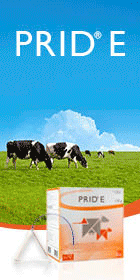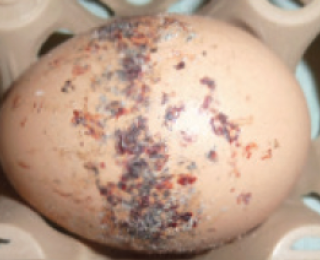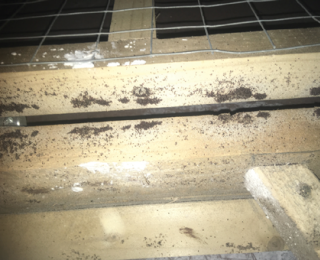Focus > Farm animal - May 2020
Poultry red mite – prevalence, problems, prevention
Maureen Prendergast MVB CertVR CertES (Orth) PhD MRCVS, technical manager for Integrated Livestock at MSD Animal Health, highlights the prevalence of and the dangers posed by the poultry red mite
Click on image to view
Dermanyssus gallinae or the poultry red mite (PRM) is the most significant ectoparasite pest of laying hens worldwide and represents a severe threat to poultry production in Europe.1 In addition, PRM infestations pose serious animal health and welfare concerns and are an increasing public health risk.2 These extremely destructive nocturnal ectoparasites suck blood from host birds at night and then hide in the cracks, crevices and litter of poultry houses when they are not feeding during the day.3 They locate their host by means of temperature, vibrations and lower atmospheric carbon dioxide.4 Adult mites measure about 1mm long, weigh about 76μg (unfed) to 280μg (after a single blood meal), and are red in colour after feeding, but they appear black, grey or white without host blood in their system.2
High prevalence
Recent surveys have confirmed the high and increasing prevalence of infestations of PRM. The average overall infestation rate of European layer houses has been estimated at 83% to 94%. Extrapolation of these estimates suggests that about 300 million hens in Europe are potentially suffering from mite infestations at any point in time. PRMs are found in all production types, from backyard or organic farms to intensive, enriched cage or barn systems.2
Poultry red mite life cycle
The direct mite life cycle can be as short as seven days at ideal temperatures above 20oC (see Figure 1), which allows for rapid growth of mite populations. Heavy infestations of around 50,000 mites/hen in caged systems and up to 500,000 mites/hen in severe cases have been reported. Typical mite density ranges between 25,000 and 50,000 mites/hen, levels that can induce aggressive feather-pecking and cannibalistic behaviour, changes in feed and water intake and decrease general condition. The most severe infestations occur in the warm season, from May to October, but mites can survive between flocks without a blood meal for up to eight months.3 While females may lay eggs at 5oC the eggs will not hatch until the temperature reaches 15oC and the mite reproduction cycle is greatly increased by increasing temperatures up to 35oC.5
Physiological damage
Chickens can develop anaemia due to repeated mite bites, with laying hens possibly losing more than 3% of their blood volume every night and disrupting their sleep patterns. In extreme cases, infestations may be so high that hens become severely anaemic and die from blood loss alone.3
Mite bites are also painful and induce skin irritation contributing to high stress levels in infested birds. Increased self-grooming and head scratching both day and night are associated with a 1.5-fold increase in corticosterone blood levels and a 22% decrease in β-globulin levels, indicative of somatic stress and immunosuppression. The adrenaline levels are also more than twice as high than in control animals, indicating psychogenic stress.6
Economic damage
PRM infestations severely affect the egg industry. Consequences of red mite infestation in a layer operation produce a negative impact on feed conversion ratio, reduced egg production, an increase in downgraded eggs and increased susceptibility to poultry diseases. A 2013-2014 FAO poultry census estimates the number of layer chickens in the 17 largest egg-producing countries in Europe to be 431 million. Recently, a large layer genetics supplier estimated that productivity losses can reach €0.57 per hen per year in case of moderate mite infestation. The total cost of D. gallinae infestation can be up to €1 per laying hen per year, depending on the housing system, the infestation intensity and the control methods used.8 Based on the recent poultry census data, the updated average infestation prevalence (83%2), and recent per bird cost calculations, it has been estimated that the current cost of red mite infestation for the egg industry in Europe to be about €200 million for productivity losses and up to about €360 million for overall costs.7,9
Poultry red mites as vectors of disease
In addition to their effects on poultry production, PRMs can spread an array of diseases to humans and poultry.2,10 Many bacterial and viral pathogens that affect both humans and poultry have been either isolated from red mites or had mite-vectored transmission demonstrated in laboratory settings, including: Salmonella gallinarum and enteritidis, Pasteurella multocida, Escherichia coli, Mycoplasma synoviae, Erysipelothrix rhusiopathiae, Borrelia burgdorferi and viral diseases including Newcastle Disease and avian influenza.
Human health concerns
PRM infestation is increasingly responsible for human dermatological lesions (gamasoidosis), particularly in people living or working in close proximity to poultry. In fact, red mites in poultry production buildings are recognized as a significant occupational hazard to poultry workers. In a 2011 report, 19% of poultry workers10 reported pruritic skin eruptions from PRMs.11 A recent survey reported an increasing incidence of gamasoidosis worldwide that is exacerbated by the persistence of mite infestation, treatment failures and the potential transmission of zoonotic diseases by the mites (such as Borrelia burgdorferi, the cause of Lyme disease; Babesia spp.; Bartonella spp.).9
Control of PRMs
PRMs are difficult to control as they can be transferred between flocks by crates, clothing and wild birds, and they can be difficult to detect unless birds are examined at night when mites are feeding. Most methods for managing red mites fail to keep infestations under control in poultry farms.2 Simply removing the host from an area will not eliminate the mites, as deutonymphs and adults are known to resist desiccation and live as long as eight months without feeding.2 Furthermore, recent European legislation (2012) banning use of traditional cages for poultry birds (European Council Directive 1999/74/EC) has favoured the use of housing systems incorporating more complex environments. While these animal welfare measures represent positive advancements for poultry husbandry, such housing systems appear to favour red mite proliferation and exacerbate infestation problems by providing mites more hiding possibilities, thus enabling them to more easily escape control measures.2,3
Chemical control of mites is often attempted, involving treatment/spraying of the local environment including walls, floors, roosts, nest boxes and birds. Organophosphates are commonly used but many products have been withdrawn because they did not comply with European or national regulatory requirements regarding human consumer and user safety. Users need to wear protective clothing during treatment and cannot re-enter the treated house for at least 12 hours after treatment and a 12-hour egg withdrawal period must be observed after treatment.2,3
Precautions also apply for most other premises-spray/pesticide approaches to red mite control. Several acaricidal spray products (pyrethroids, carbamates, abamectin and spinosad) are available in some European countries for the treatment of the poultry house and equipment (not birds), mainly for use during the unoccupied period between flocks. If used when the hens are present, if there is no residue limit for eggs, there may be a risk of contamination of feed or hens. Many chemical applications have a short residual activity, exert little or no effect on mite eggs and are prone to resistance development due to the selection of resistant mites that survive exposure to sublethal concentrations due to uneven spraying, especially inside crevices and cracks.3 Even new alternative solutions developed in recent years, including essential oils, predator mites, heat treatments, intermittent lighting programs and inert dusts (eg. silica, diatomaceous earth) while reducing the level of mites in houses, will not fully control the populations.2
Treatment
A novel licensed product containing fluralaner can be used for the destruction of PRMs biting the hens by systemically treating host birds via drinking water instead of treating the animal facilities.12 Fluralaner is a potent inhibitor of the arthropod nervous system and acts antagonistically on ligand-gated chloride channels (GABA-receptor and glutamate-receptor). The product is approved for treatment and control of PRM infestation in pullets, breeders and layers when provided in drinking water administered twice seven days apart killing mites for the 15 days that the product is bioavailable in the hens. This second application is designed to kill a new wave of mites that have hatched and will be biting the hens following the death of the adults on the first day of application. Moreover, the product has a zero-day withdrawal period for eggs and a 14-day withdrawal period for meat and a high safety profile for the operator and the birds. Free-range birds need to be housed for the period that they are consuming the product.12
Always use medicines responsibly. Seek advice from your prescribing vet regarding the most appropriate control measures to implement on your farm.
-
Chauve C. (1998) The Poultry Red Mite Dermanyssus gallinae (De Geer, 1778): Current situation and future prospects for control. Vet Parasitol 79:239-245.
-
Sparagano OAE, George DR, Harrington DWJ, Giangaspero A. (2014) Significance and control of the Poultry Red Mite Dermanyssus gallinae. Annu Rev Entomol 59:447-466.
-
Flochlay AS, Thomas E, Sparagano OAE. (2017) Poultry red mite (Dermanyssus gallinae) infestation: a broad impact parasitological disease that still remains a significant challenge for the egg-laying industry in Europe. Parasites & Vectors 10: 357
-
Kilpinen O. (2005) How to obtain a blood meal without being eaten by a host: the case of Poultry Red Mite, Dermanyssus gallinae. Physiol Entomology 30:232-240.
-
Tucci EC, do Prado AP, de Araújo RP (2008) Thermal requirements of Dermanyssus gallinae (De Geer, 1778) (Acari: Dermanyssidae). Rev Bras Parasitol Vet. 17:67-72.
-
Kowalski A, Sokol R (2005) Influence of Dermanyssus gallinae (Poultry Red Mite) invasion on the plasma levels of corticosterone, catecholamines and proteins in layer hens. Polish J Vet Sci; 12:231-235.
-
Sparagano OAE et al. (2009) Prevalence and key figures for the poultry red mite Dermanyssus gallinae infections in poultry farm systems. Exp Appl Acarol. 48:3–10
-
Mozafar F. (2014) Poultry Red Mite, a big challenge for egg producers. Frühjahrveranstaltung; Deutchen Vereinigung für Geflügelwissenschaft. Leipzig, 11-12 März 2014
-
Van Emous R. (2017) Verwachtte schade bloedluis 21 miljoen euro. Pluimveeweb.nl. https://www.pluimveeweb.nl/artikelen/2017/01/schade-bloedluis-21-miljoen-euro/. Accessed 16/04/20
-
George DR et al. (2015) Should the Poultry Red Mite Dermanyssus gallinae be of wider concern for veterinary and medical science? Parasites & Vectors 8:178.
-
Cafiero MA, et al. (2011) Why dermanyssosis should be listed as an occupational hazard. Occup Environ Med. 68:628.
-
Thomas et al. (2017) Field efficacy and safety of fluralaner solution for administration in drinking water for the treatment of poultry red mite (Dermanyssus gallinae) infestations in commercial flocks in Europe. Parasites & Vectors. 10:457












